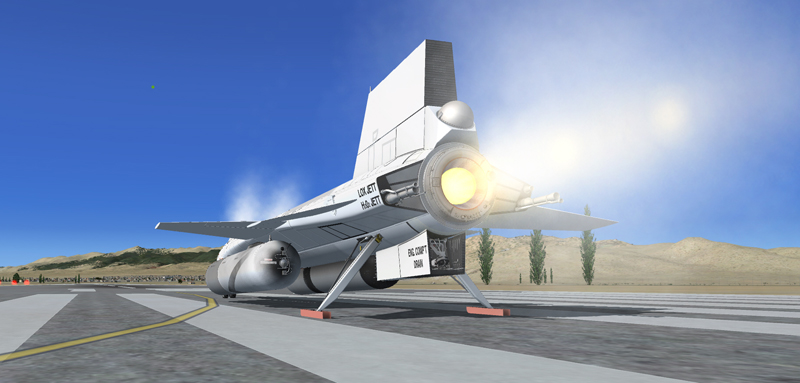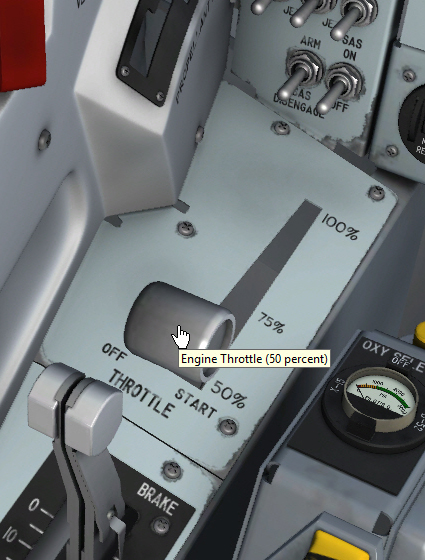
Engine ignition (Prepar3D® v2 screenshot).
After release from the "carrier airplane" or when ready to take off from the runway, proceed as follows:
- Parking/differential brake (if applied, takeoff only) – RELEASED ("." key).
- Throttle [12, fig. 5-4] – START (click and then move inboard to 50%). Throttle must be moved to 50% by the time the idle-end (amber) caution light [2b, fig. 5-1] comes on. Note that combustion in the main thrust chamber of the XLR-99 engine will start almost instantaneously when the throttle lever is moved from OFF to START 50%.
- As soon as the aircraft is airborne, raise the landing gear by pushing the landing gear handle [65, fig. 5-1] on the left wing panel (or by pressing the "G" key on your keyboard or the appropriate button on your joystick).
- Chamber and stage 2 igniter pressure gauge [50, fig. 5-1] – Check (large pointer, 335 to 600 psi within 2 seconds, depending on throttle position; small pointer 350 to 630 psi, depending on throttle position).
- Propellant manifold pressure gauge [51, fig. 5-1] – Check ("L" pointer, 455 to 980 psi; "A" pointer, 510 to 1155 psi).
- Propellant (helium) source pressure gauge [69, fig. 5-1] – Check (both internal and external tanks, 3300 to 3900 psi).
- H2O2 source and purge (helium) pressure gauge [57, fig. 5-1] – Check (both internal and external tanks, 3300 to 3900 psi).
- Propellant tank pressure gauge [71, fig. 5-1] – Check ("L" pointer, 45 to 65 psi; "A" pointer, 45 to 65 psi).
- H2O2 tank and engine control line pressure gauge [55, fig. 5-1] – Check (both pointers, 575 to 615 psi).
- External tanks fuel flow indicator on the main instrument panel [4, fig. 5-1] – 50% to 100%.

Engine throttle.
Engine Thrust Control
Engine thrust is controlled by movement of the throttle between 50% and 100% thrust. Engine response to throttle movement is very rapid, 50% to 100% in approximately 1.5 seconds.
Normal Indications during Start
When the main thrust chamber is fired, the following indications will be evident:
- Turbine exhaust steam will be seen at the back of the aircraft;
- Liquid oxygen and ammonia will automatically stop bleeding overboard (as observed during prime);
- Liquid oxygen and ammonia manifold pressure will rise to rated values;
- Igniters will be operating;
- Chamber pressure will rise to a point where the igniters cease firing and chamber pressure will be shown on the indicator gauge;
- Airplane propellants will be consumed at a very high rate;
- Chamber pressure will reach rated values;
- Thrust chamber will emit a great deal of noise;
- Flames and exhaust gases (smoke, steam) will be seen at the back of the airplane.
See also:
Engine controls
Engine indicators

